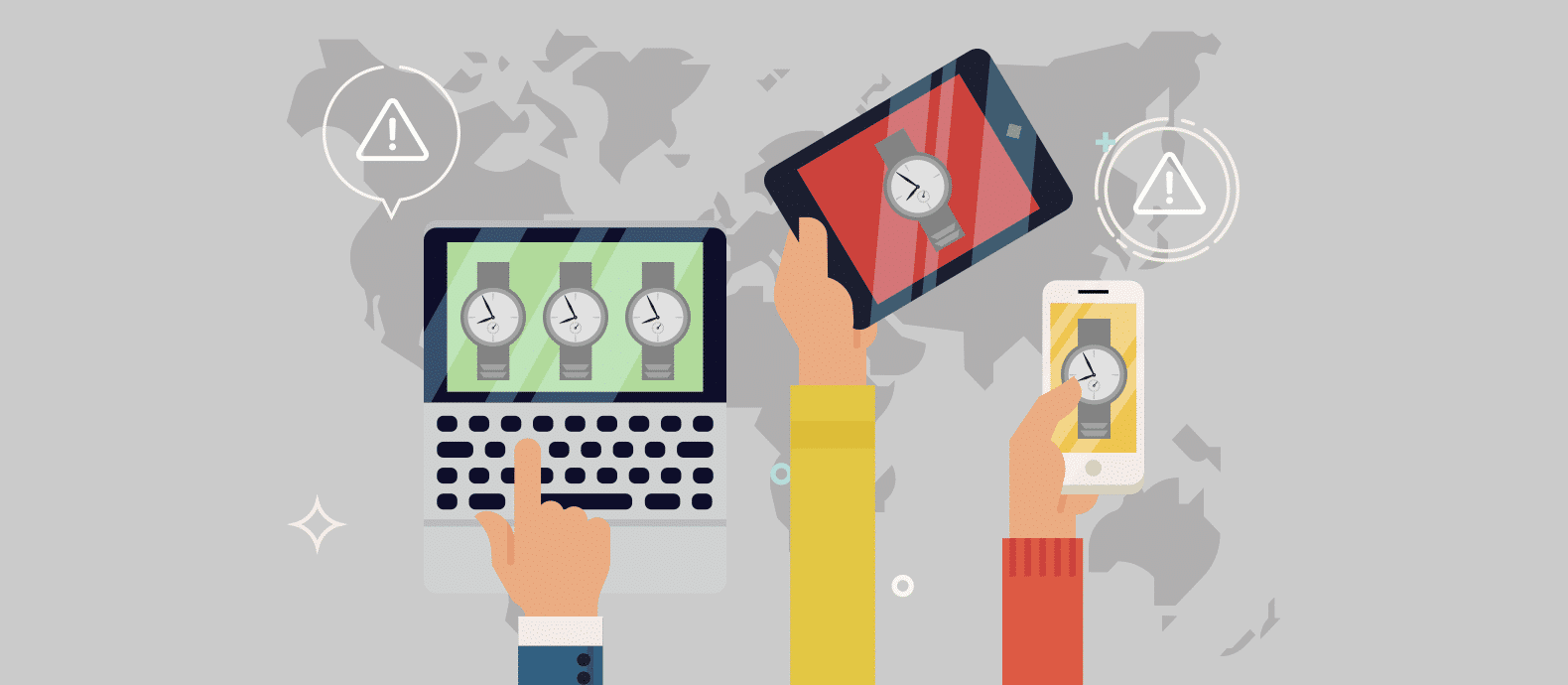Ever wondered what you need to do to guard your brand against scammers, counterfeiters, cybercrime and security breaches? Here’s our ultimate guide to brand protection, including intellectual property definitions, forms of brand abuse facing brands, actionable tips for protecting your brand, and more.
In this article, we discuss:
- What brand protection is
- What brand abuse is
- What brand protection services do
- Brand protection services
- The consequences of counterfeiting for brands
- How to protect your brand
- Whether you need brand protection
- How brands can recover revenue with brand protection

What is brand protection?
Brand protection is the process of protecting the intellectual property (IP) of companies and their associated brands against counterfeiters, copyright pirates, and infringers of other types of IP, such as patents, design rights, color marks and trade dress.
This is done not only to protect the loss of revenue from a company but also to protect a company’s image, reputation and overall value. Fundamentally, brand protection prevents brand abuse.
What is brand abuse?
Brand abuse is an umbrella term that refers generally to an outside party infringing on a brand’s intellectual property in order to take advantage of its well-respected reputation. Brand abuse can come in many forms, including, but not limited to:
- Counterfeiting
- Rogue websites
- Copyright piracy
- Trademark squatting
- Patent theft
- Social media impersonation
Companies need to remain vigilant against any type of brand abuse of which they may become a target. However, the most pervasive and troublesome for brands is counterfeiting.
What is counterfeiting?
A counterfeit product imitates the product from an authentic brand, but is made unofficially, by external sources. The fake product will use the logos and trademarks of the authentic brand without permission, in order to deceive customers.
For some perspective, trade in counterfeit and pirated goods amounted to up to 2.5% of world trade. To put this in real terms, counterfeiting is worth more than Ireland’s economy.
Counterfeiting is just one form of intellectual property infringement, as it specifically targets the trademarks of an authentic brand. So, working against counterfeiting is the primary goal of brand protection companies and services.
Domain spoofing
Rogue websites are sites created for malicious intent, either against a legitimate company or by infringing its IP. They come in a number of variations:
- Cybersquatters; sites that claim domain names in order to take advantage of other brands’ trademarks.
- Typosquatters; these rely on internet users making mistakes while typing in the address of other websites.
- Imitation sites; websites that attempt to completely pass themselves off as the website of an existing authentic brand.
Copyright infringement
A copyright is a legal protection granted to creators of artistic, literary, and scientific works. Companies need to be protective of their copyright and have a strong brand protection strategy, even if they’re not creating art, books or scientific reports. Counterfeiters will copy a product’s authentic photographs and use them to promote and legitimize their own illegal product listings online.
Trademark infringement
Trademark infringement happens when counterfeit sellers intentionally deceive consumers into purchasing a product which they believe is from a legitimate brand. This damages consumers and brands that are trying to operate properly. Unintentional trademark infringement can also occur when a phrase, product feature, or brand logo “is likely to cause consumer confusion as to the source of those goods” (Overview of Trademark Law).
Trademark squatters register trademarks in bad faith. This can come in a number of forms, including foreign registration of marks belonging to brands yet to register abroad, and transliteration issues, like the Jordan/Qiaodan case.
Patent theft
Patents are legal protections given to inventive products which provide an innovative solution to a problem. Inventors who have created a new product are entitled to patent protection, as it forbids outside parties from using their designs, and outside parties infringing on patents will profit from the time and money invested into designing the invention.
There are two main kinds of infringement to lookout for when it comes to patent theft: Design Patent Infringement and Utility Patent Infringement.
Under US law, Design patent infringement happens when someone applies a “patented design, or any colorable imitation thereof, to any article of manufacture for the purpose of sale”. It is an entirely visual criteria that can be avoided if the design looks different enough. In contrast, utility patent infringement is concerned with the creation of a new or improved product, machine, or process. The criteria is not visual. Instead, infringement will be assessed on the functional similarities and will relate to the utility of the process, machine, or product.
Social media impersonation
Counterfeiting, and forms of IP theft in general, are growing quickly on social media, and is a big online brand protection challenge for many companies.
Unofficial third parties create social media accounts imitating authentic brands, then use their fake profiles to sell counterfeits, send users to phishing pages, and sometimes to distribute harmful malware.
NFT copyright infringement
The ownership rights of any NFT belong to the person who mints the NFT. If one were to mint an NFT belonging to someone else this essentially amounts to stealing and will be classed as an NFT copyright infringement.
To protect your brand from NFT infringements you have to first discover whether there are any active infringers stealing your content. This can be accomplished by monitoring global NFT marketplaces. When fraudulent cases are found, a service like Red Points, can automatically take down infringing listings, pursue repeat infringers, and reveal trends in the field to ensure that you can protect against scammers.
What do brand protection services do?
Brand protection services ensure that no IP infringement goes unchecked, allowing you to have peace of mind about the security of your products. Brand abuse monitoring software providers, like Red Points, automatically monitor and takedown any infringing online assets.
Save Time: Do more in less
Brand protection services allow you to optimize your workflow and concentrate on the essential elements of your product. Automatic bot-powered searches and advanced image recognition will crawl the web discovering potential infringements. Automated parameters and machine learning will allow you to sit back and relax while the brand protection software works to identify infringers.
Prioritize: Bigger threats first
Brand protection services can prioritize the threats to your brand and focus on high-risk targets. They will allow you to uncover the top infringing sellers and platforms, group IP infringements and put you in a position to act on them straight away.
Take Action: Enforce automatically
Brand protection services will also help to enforce by removing infringements automatically and at a large scale. The best service will let you set up rules that instantly enforce against counterfeiters. Most brand protection services will also enable you to manually review and decide what listings to take down. After enforcement you will then be able to monitor listings and sellers to help you stop them from reemerging.
Keep Track: Know your impact
Brand protection doesn’t stop at enforcement. The top brand protection services will allow you to measure and access the economic impact of the brand protection actions. They will provide deep, insightful analysis that is tailored to your brand and your protection goals.
How to assess and compare brand protection services
So, what makes a truly great brand protection service? Here are a few of the key metrics you need to look out for before investing in a brand protection service.
Scale
What is the scale of your issue? In order for you to spend wisely and efficiently it is important that you understand the scale of infringements that you are facing. Are you dealing with an isolated incident or is it a recurring issue across multiple platforms and marketplaces? Once you understand the scale of the task ahead, you will be able to adequately assess whether the potential brand protection service is appropriately scalable. A qualified brand protection solution should be capable of auditing and assessing the current risk your brand is facing and offer a corresponding solution.
Reach
Technology has enabled brand infringements to reach previously inaccessible platforms.. If you want to tackle various cases of IP infringement and continually monitor your brand, the reach and search capacity of the service is a critical factor to consider. Ideally, you will want a service that has automated technology and machine learning with options to manually tailor or extend the reach of your search parameters. The best services will be searching across the entire web, not just top-ranking marketplaces, such as Amazon and eBay.
Success rate
In general, you should look for positive reviews and expect success rates above 80%, with at maximum a three-day window for the successful removal of infringements.
The best brand protection solutions will clearly display their success rate somewhere on their product page or in client case studies. You don’t want to pursue any solution that has a success rate below 80%. Anything above 90% is excellent and demonstrates a high level of brand protection.
Technology
Is this brand protection service using the most modern and effective technology? This is a vital question because it determines your ability to detect and tackle infringers who are constantly finding new and inventive ways to steal and mislead. Does the solution you are checking use machine learning and automation?
Innovation is a must in the digital global counterfeit industry, staying up-to-date with keywords that identify future threats to your brand, and using given data to customize the service delivered keeps you winning ahead of cyber criminals. To stay one step ahead of infringers, the best protection providers will constantly work to invest in, and integrate, the best new technologies.
Reporting
How successful were your brand protection efforts? The best protection solutions will provide you with an advanced and insightful reporting system, usually via an app or visual web dashboard.
Once infringements have been detected and acted upon, a good brand protection service will let you see the results. You will be able to observe in detail and highlight websites and areas of particular risk. You should consider whether the service you want to use will be able to provide you with real-time data and weekly/monthly reports. The best brand protection platforms will give you access to both, ensuring that you can stay as informed as possible.
The consequences of counterfeiting for brands
The problems caused by counterfeiters targeting a legitimate brand are more numerous and deeper reaching than many brands understand. Counterfeiting does not simply mean a few people are making money as an isolated black market venture. Rather, the impacts on brands can be quite severe:
- Falling sales – If counterfeiters are able to produce IP-protected products, and can offer them at a considerably lower price than the authentic brand, then that brand will undoubtedly suffer a considerable hit to their sales.
- Reputation – Brands work hard to establish a reputation for themselves in the public eye. If a company without brand protection strategy is targeted by counterfeiters its reputation can be put in jeopardy, leading potential customers to avoid your brand in favor of brands seen as more reliable, trustworthy and high-quality.
- Attending to deceived customers – Many consumers of counterfeit products are unaware they are buying fake products when they make the purchase. When counterfeits prove themselves to be low-quality goods, the consumers take them to the authentic brand for replacements and are frustrated to learn they had been duped.
- Losing trust with your partners – The actions of counterfeiters can massively undermine the trust between businesses that can take years to develop. Distributors will see counterfeiters offering products for far cheaper than the minimum price agreed upon with the authentic brand, or think their exclusive rights are being betrayed and will blame the brand they’d been working with for years.
- The resources it costs to fight counterfeits – Even the act of fighting back against counterfeiters can be a slow and expensive process that draws resources from other departments of a business. Huge sums of money can be invested in paying lawyers in an attempt to protect the brand and keep the counterfeiting troubles at a minimum, usually to little avail.
How to protect your brand
Knowing how to keep intellectual property protected is essential knowledge for many brands. Counterfeiters are persistent when targeting companies they think they can profit from, and will use any and every tactic at their disposal to stay in business.
There are a number of brand protection strategies that companies can implement to help them in the fight against infringers, both offline and in the online world.
- Register your IP – Without formally registering intellectual property, there is very little real legal recourse for brands who suffer from brand abusers. In fact, without trademarks formally registered, counterfeiters would be free to rip off logos and brand names. Getting intellectual property registered needs to be the first step for creating an online brand protection strategy.
- NDAs with partners – This is especially important for brands with patent-protected designs and processes. Agreeing to work with other companies without protections for confidential information can put a brand at a huge risk.
- Fight rogue websites – Rogue websites are sites set up for malicious or criminal purposes. They come in a number of variations, all of which are potentially damaging to brands. You can protect your brand by registering relevant domain names to your brand and removing harmful sites.
- Have a strong social media presence – As social media grows as an important platform for counterfeiters, brands need to maintain a strong presence to establish themselves as authentic. Using on-site reporting tools and using undercover accounts are vital to removing bad actors on social media.
- Educate your customers – Customer education can be used to great effect in brand education in two ways. Helping customers to recognize the differences between legitimate products and fakes will better equip them to avoid getting tricked. Educating people on the overall harms of counterfeiting will also make them less likely to seek out knockoff products.
Do I need brand protection?
If you sell a trademarked product, then you are potentially at risk of counterfeiting, and you need to seriously consider employing a brand protection strategy.
Having said that, there are three main types of companies that are at an especially high risk of being targeted by counterfeiters: product innovators, brand value companies and design-focused companies.
The reason these types of companies are so commonly at risk of counterfeiting is that of the huge investment of time and effort they put into building a respected brand, running their products’ research and development, and carefully designing their products before they’re even launched.
How brands can recover revenue with Brand Protection
One of the most compelling reasons to invest in brand protection is that it enables you to recover lost revenue and restore your brand reputation. Revenue recovery is all about getting money back from counterfeiters.
Brand Protection services like Red Points can help you recover revenue by targeting high-profile infringers and building a robust data-based case against them. Our partners will undertake legal action on your behalf to stop the infringements and recover funds.
Red Points has helped a variety of top enterprise brands recover revenue with our Revenue Recovery Platform. For example, Red Points helped the shoes and clothing brand FILA take down $200 million worth of fake products online and continues to work with Fila to prepare for new threats. Red Points also helped the board game brand CATAN remove over 224,359 fraudulent product listings, which is equivalent to over $7 million in revenue. Thanks to our revenue recovery system top brands are able to recover money, regain momentum and make their brand more secure for the future.
What’s next
If you are serious about growing your brand and protecting your business from bad actors then now is the time to invest in a first-class brand protection solution. Without proper protection you will leave your brand open to counterfeiters, copycats and scammers intent on stealing your IP and siphoning away your profits.
The only way to tackle this issue is by investing in a brand protection platform that detects and removes counterfeiters wherever they may be lurking. Red Points’ Brand Protection Platform specializes in getting rid of pesky scammers and recovering any revenue you may have already lost to them. If you are keen to learn more head over to our Brand Protection Software page and request a demo.







